
Telesto is a moon of Saturn. It was discovered by Smith, Reitsema, Larson and Fountain in 1980 from ground-based observations, and was provisionally designated S/1980 S 13. In the following months, several other apparitions were observed: S/1980 S 24, S/1980 S 33, and S/1981 S 1.

Rhea is the second-largest moon of Saturn and the ninth-largest moon in the Solar System, with a surface area that is comparable to the area of Australia. It is the smallest body in the Solar System for which precise measurements have confirmed a shape consistent with hydrostatic equilibrium. Rhea has a nearly circular orbit around Saturn, but it also orbits synchronously, like many of Saturn's other major moons; that is, it rotates at the same speed it revolves (orbits), so one hemisphere is always held facing inwards to the planet.

Helene is a moon of Saturn. It was discovered by Pierre Laques and Jean Lecacheux in 1980 from ground-based observations at Pic du Midi Observatory, and was designated S/1980 S 6. In 1988 it was officially named after Helen of Troy, who was the granddaughter of Cronus (Saturn) in Greek mythology. Helene is also designated Saturn XII (12), which it was given in 1982, and Dione B, because it is co-orbital with Dione and located in its leading Lagrangian point (L4). It is one of four known trojan moons.

Pan is the innermost named moon of Saturn. It is a small, ravioli-shaped moon approximately 35 kilometres across and 23 km wide that orbits within the Encke Gap in Saturn's A Ring. Pan is a ring shepherd and is responsible for keeping the Encke Gap free of ring particles. It is sometimes described as having the appearance of a walnut.

Thebe, also known as Jupiter XIV, is the fourth of Jupiter's moons by distance from the planet. It was discovered by Stephen P. Synnott in images from the Voyager 1 space probe taken on March 5, 1979, while making its flyby of Jupiter. In 1983, it was officially named after the mythological nymph Thebe.
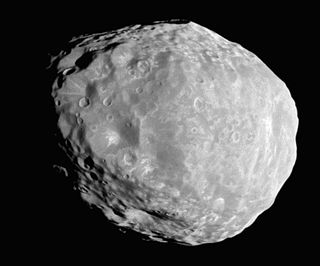
Janus is an inner satellite of Saturn. It is also known as Saturn X. It is named after the mythological Janus. This natural satellite was first identified by Audouin Dollfus on December 15, 1966, although it had been unknowingly photographed earlier by Jean Texereau. Further observations led to the realization that Janus shares a unique orbital relationship with another moon, Epimetheus. The discovery of these two moons' peculiar co-orbital configuration was later confirmed by Voyager 1 in 1980.

Epimetheus is an inner satellite of Saturn. It is also known as Saturn XI. It is named after the mythological Epimetheus, brother of Prometheus.
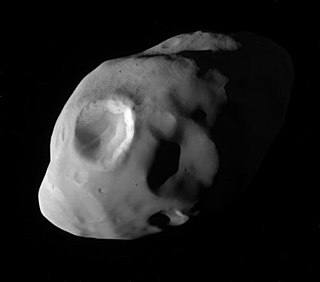
Pandora is an inner satellite of Saturn. It was discovered in 1980 from photos taken by the Voyager 1 probe and was provisionally designated S/1980 S 26. In late 1985, it was officially named after Pandora from Greek mythology. It is also designated as Saturn XVII.
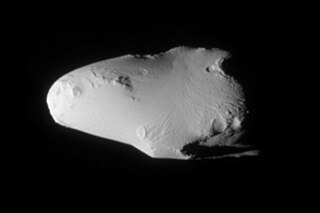
Calypso is a moon of Saturn. It was discovered in 1980, from ground-based observations, by Dan Pascu, P. Kenneth Seidelmann, William A. Baum, and Douglas G. Currie, and was provisionally designated S/1980 S 25. Several other apparitions of it were recorded in the following months: S/1980 S 29, S/1980 S 30, S/1980 S 32, and S/1981 S 2. In 1983 it was officially named after Calypso of Greek mythology. It is also designated Saturn XIV or Tethys C.

Prometheus is an inner satellite of Saturn. It was discovered on 24 October 1980 from photos taken by the Voyager 1 probe, and was provisionally designated S/1980 S 27.

The moons of Saturn are numerous and diverse, ranging from tiny moonlets only tens of meters across to the enormous Titan, which is larger than the planet Mercury. There are 146 moons with confirmed orbits, the most of any planet in the solar system. This number does not include the many thousands of moonlets embedded within Saturn's dense rings, nor hundreds of possible kilometer-sized distant moons that were seen through telescopes but not recaptured. Seven Saturnian moons are large enough to have collapsed into a relaxed, ellipsoidal shape, though only one or two of those, Titan and possibly Rhea, are currently in hydrostatic equilibrium. Three moons are particularly notable. Titan is the second-largest moon in the Solar System, with a nitrogen-rich Earth-like atmosphere and a landscape featuring river networks and hydrocarbon lakes. Enceladus emits jets of ice from its south-polar region and is covered in a deep layer of snow. Iapetus has contrasting black and white hemispheres as well as an extensive ridge of equatorial mountains among the tallest in the solar system.
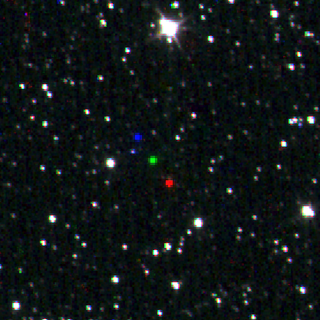
Siarnaq, also designated Saturn XXIX, is the second-largest irregular moon of Saturn. It was discovered on 23 September 2000 by a team of astronomers led by Brett J. Gladman. It was named after the Inuit goddess of the sea, Siarnaq, who is more commonly known as Sedna. Siarnaq is the largest member of Saturn's Inuit group of prograde irregular moons, which orbit far from Saturn in the same direction as the planet's rotation. The moons of the Inuit group are believed to have originated as fragments from the collisional breakup of a larger progenitor moon after it was gravitationally captured into orbit around Saturn several billion years ago. Several other small Inuit group moons share similar orbits to Siarnaq, indicating that the moon had experienced another collision after forming from its progenitor.
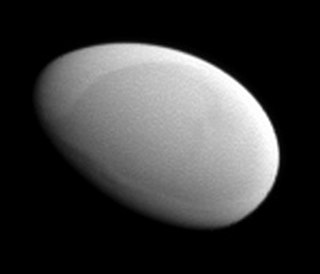
Methone is a small, egg-shaped natural satellite of Saturn that orbits out past Saturn's ring system, between the orbits of Mimas and Enceladus. It was discovered in 2004, though it wasn't until 2012 that it was imaged in detail by the Cassini spacecraft.

Pallene is a very small natural satellite of Saturn. It is one of three small moons known as the Alkyonides that lie between the orbits of the larger Mimas and Enceladus. It is also designated Saturn XXXIII.
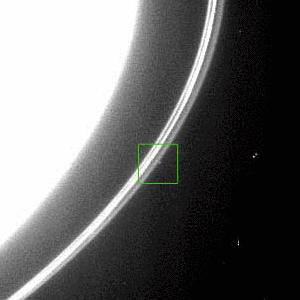
S/2004 S 3 is the provisional designation of an object seen orbiting Saturn just beyond the outer strand of the F ring on June 21, 2004. It was discovered by the Cassini Imaging Science Team in images taken by the Cassini–Huygens probe on June 21, 2004 and announced on September 9, 2004.

Polydeuces, also designated Saturn XXXIV, is a small trojan moon of Saturn occupying the trailing L5 Lagrange point of Dione. It was discovered by the Cassini Imaging Science Team in images taken by the Cassini space probe on 21 October 2004. With a mean diameter of about 3 km (1.9 mi), Polydeuces is thought to have a smooth surface coated with fine, icy particles accumulated from the cryovolcanic plumes of Enceladus. In its orbit around Saturn, Polydeuces periodically drifts away from Dione's Lagrange point due to gravitational perturbations by other nearby moons of Saturn. Of the four known trojan moons of Saturn, Polydeuces exhibits the largest displacement from its Lagrange point.

Daphnis is an inner satellite of Saturn. It is also known as Saturn XXXV; its provisional designation was S/2005 S 1. Daphnis is about 8 kilometers in diameter, and orbits the planet in the Keeler Gap within the A ring.

Anthe is a very small natural satellite of Saturn lying between the orbits of Mimas and Enceladus. It is also known as Saturn XLIX; its provisional designation was S/2007 S 4. It is named after one of the Alkyonides; the name means flowery. It is the sixtieth confirmed moon of Saturn.
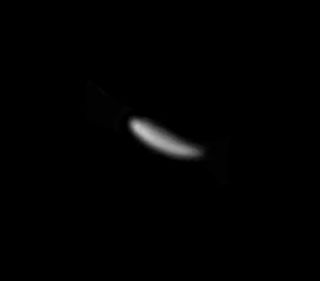
Aegaeon, or Saturn LIII, is a natural satellite of Saturn. It has an extremely elongated shape whose surface is thought to be similarly smooth as Methone. It orbits between Janus and Mimas within Saturn's G Ring.
S/2004 S 4 is the provisional designation of an unconfirmed object seen orbiting Saturn within the inner strand of the F ring on June 21, 2004. It was spotted while J. N. Spitale was trying to confirm the orbit of another provisional object, S/2004 S 3, that was seen 5 hours earlier just exterior to the F ring. The announcement was made on September 9, 2004.
























